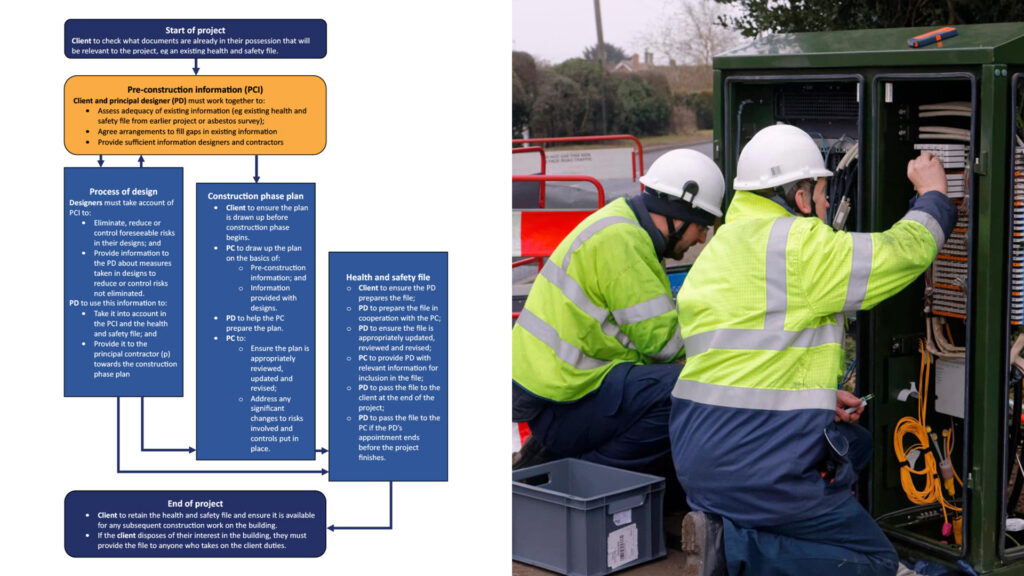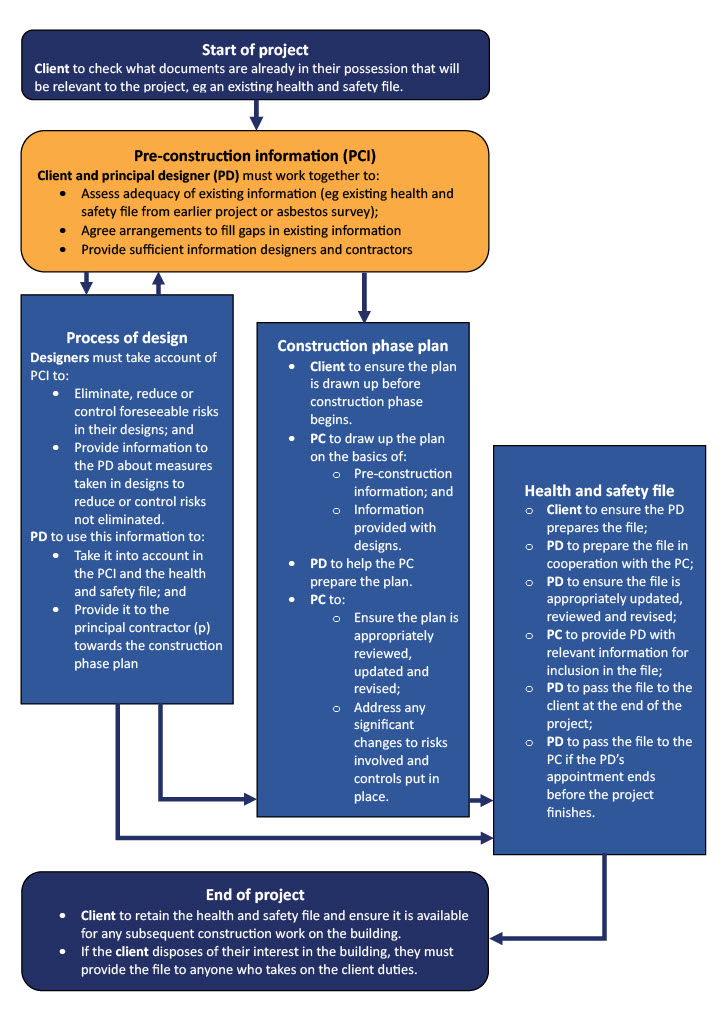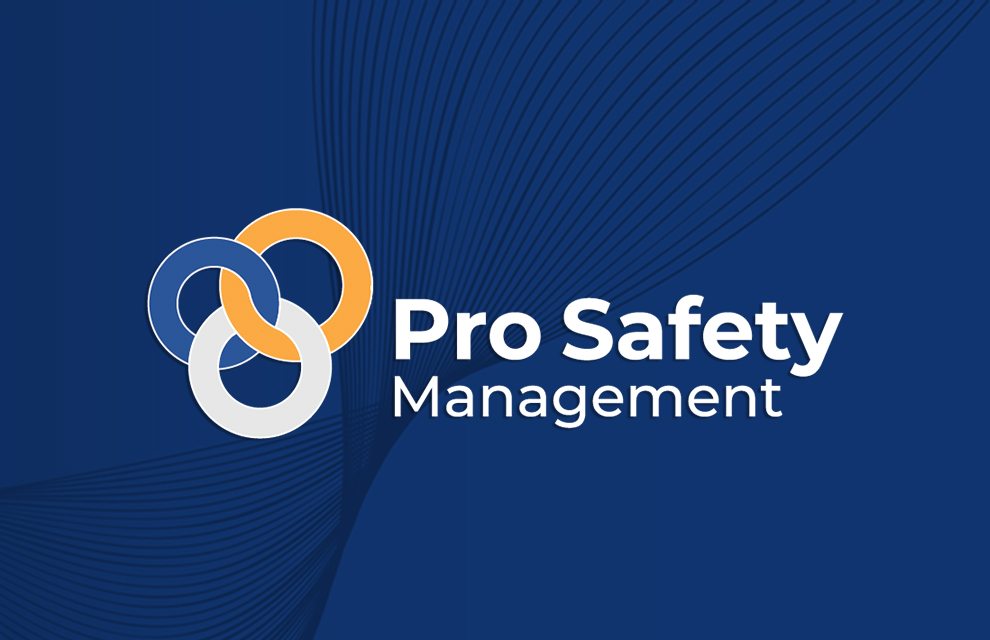
I hope you enjoy reading this blog post.
If you want my team to just do your health and safety for you, click here.
Safety Files - How these would look for a Fibre Rollout Deployment

The deployment of fibre networks is a crucial step in providing reliable, fast broadband access to communities.
However, fibre rollouts must be managed under the “The Construction (Design and Management) Regulations 2015”, where there is a requirement to compile a “Health and Safety File” when there is more than one contractor working on a network deployment, or building “Data Centres”, “Network Switch Sites”, or “ASC” (Active Street Cabinets) etc. During these construction builds, the health and safety file must be compiled to be CDM compliant.
This blog gives guidance on the preparation, provision and retention of a health and safety file when deploying a Fibre roll-out. (Please refer to the flow chart attached demonstrates how the health and safety file relates to and influences other types of information during the fibre roll-out.
Understanding Safety Files
The health and safety file is one of the most useful innovations introduced by CDM. However, it is only of value if it contains relevant, useful, and accurate information. In its correct format, the health and safety file can save lives. However, files that are filled with unhelpful and irrelevant information will be of little use and arguably could hinder the management of health and safety on a construction project.
Creating Safety Files for Fibre Rollout Deployment
According to HSE’s L153 Guidance to the Construction (Design and Management) Regulations 2015, Appendix 4, the following information should be considered for information in the health and safety file:
- a brief description of the work carried out
- any hazards that have not been eliminated through the design and construction processes, and how they have been addressed (e.g., surveys or other information concerning asbestos or contaminated land)
- key structural principles (e.g., bracing, sources of substantial stored energy, including pre- or post-tensioned members) and safe working loads for floors and roofs
- hazardous materials used (e.g., lead paints and special coatings)
- information regarding the removal or dismantling of installed plant and equipment (e.g., any special arrangements for lifting such equipment. (Prefabricated chambers)
- health and safety information about equipment provided for cleaning or maintaining the structure
- the nature, location and markings of significant services, including underground cables, gas supply equipment, fire-fighting services, etc
- information and as-built drawings of the building, its plant and equipment (eg the means of safe access to and from service voids and fire doors)
- MDU (Multi Dwelling Units) fibre installations, fire rated fixings, fire rated cables, and compartmentation / fire stopping materials used etc
The file should not include things that will be not help planning for health and safety on future construction work such as:
- the pre-construction information or construction phase plan
- construction phase risk assessments, written systems of work and COSHH assessments which were adopted during the project
- details about the normal operation of the completed structure
- construction phase accident statistics
- details of all of the contractors and designers involved in the project (though it may be useful to include details of the principal contractor and principal designer)
- contractual documents
- information about structures, or parts of structures, that have been demolished — unless there are any implications for remaining or future structures, eg voids
- information contained in other documents. Relevant cross-references should be included, however
The file should be held in a convenient location and can be in paper form or electronic form. Where the file is kept electronically, suitable back-up arrangements must be in place. The level of detail of the file must be in proportion with the risks involved, and the degree of effort and resources expended to compile the health and safety file must also be proportionate to the risks in the project.
The file needs to be kept up to date and retained for as long as it is relevant — normally the lifetime of a structure. Where clients dispose of their entire interest in a structure, they should pass the file to the new owners and ensure that they are aware of the nature and purpose of the file. Where they sell part of a structure, any relevant information in the file should be passed or copied to the new owner.
If the client leases out all or part of the structure, arrangements need to be made for the health and safety file to be made available to leaseholders. In some cases, the client might transfer the file to the leaseholder during the lease period. In other cases, it may be appropriate for the client to keep the file but inform leaseholders that it is available.
If the leaseholder acts as a client for future construction projects, the leaseholder and the original client will need to make arrangements for the file to be made available to the new principal contractor.
The health and safety file is one of the most useful innovations introduced by CDM. However, it is only of value if it contains relevant, useful, and accurate information. In its correct format, the health and safety file can save lives. However, files that are filled with unhelpful and irrelevant information will be of little use and arguably could hinder the management of health and safety on a construction project.
How different types of information relate to and influence each other in a construction project involving more than one contractor: A Summary

What would a Health and Safety File look like for Fibre Rollout Deployment?
When it comes to health and safety files for fibre deployment, the content of the file is subjective and can vary depending on the specific project and the requirements of the client.
In our experience, a health and safety file for a fibre deployment project could include:
- A brief description of the work carried out; (MDU -Multi Dwelling Units)
Installation of fibre optic cables within a 10-floor block of flats. Fibres will be brought in at basement level where an “Optical Distribution Frame” (ODF) will be wall mounted. Cables will follow the service riser to each floor. Cabling tasks involve drilling holes on each floor, and cabling to the entrance of each flat to provide Broadband capabilities.
- any hazards that have not been eliminated through the design and construction processes, and how they have been addressed (e.g., an up-to-date asbestos register provided by the landlord / council – List of companies used to provide control measures where the risk cannot be eliminated)
- key structural principles (holes drilled into the fabric of the building, and details of the 3rd party certified fire stopping company)
- hazardous materials used (any fire stopping material used)
- information regarding the removal or dismantling of installed plant and equipment (e.g., any special arrangements for lifting such equipment. (Removal of cables and correct disposal)
- health and safety information about equipment provided for cleaning or maintaining the structure. (N/A) the nature, location, and markings of significant services, including underground cables, gas supply equipment, fire-fighting services, etc. (As built drawing, showing cable routes)
- information and as-built drawings of the building, its plant and equipment (e.g. the means of safe access to and from service voids and fire doors – Location of ODF and marked locations of confined spaces )
- MDU (Multi Dwelling Units) fibre installations, fire rated fixings, fire rated cables (Cca cables give off significantly less kW of heat when burning when compared with Dca cables, this can reduce the risk of flash over during a fire situation) , and compartmentation / fire stopping materials used etc.)
Struggling with your Health and Safety File?
If you’re struggling with creating a health and safety file for your fibre deployment project, we’re here to help. Our team of experts has extensive experience in creating comprehensive health and safety files that comply with all relevant regulations and standards.
Do you want better compliance?
Hey, I’m Alex Burbidge. I’m determined to make a business health and safety compliant. My only question is, will it be yours?

About Pro Safety Management
We are a Specialist Telecoms Health and Safety Consultancy with over 40+ years experience. Serving some of the global leading telecommunication companies, we provide specialist and strategic health and safety management ensuring operational standards at the highest level.
Do you want better compliance?
Hey, I’m Alex Burbidge. I’m determined to make a business health and safety compliant. My only question is, will it be yours?


